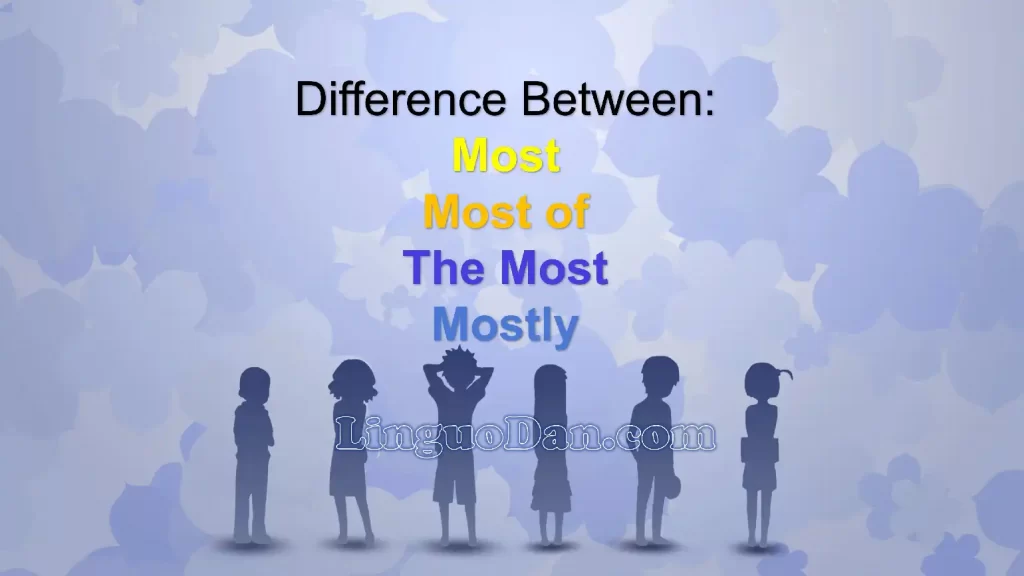Difference Between: Most, Most of, The Most, and Mostly

What is the difference between: “Most,” “Most of,” “The Most,” and “Mostly”
The English language can be challenging, especially when it comes to understanding the nuances between similar expressions. In this article, we will explore the differences between four commonly used phrases: “most,” “most of,” “the most,” and “mostly.” By delving into the distinctions of these terms, you can significantly enhance your comprehension and adeptness in using the English language.
Most
The word “most” is a superlative form of the adjective “many” or “much.” It is used to describe the majority or largest portion of something. For example:
- Most people prefer coffee over tea.
- Most of the students passed the exam.
In both cases, “most” indicates the highest quantity or number within a given group.
Below are the rules for using “most” in combination with nouns to express ‘the majority of’ something and general trends in a broader context.
- “Most” is used without articles like ‘the/this/that/my/etc.’ when paired with nouns to represent ‘the majority of’ something.
- “Most” can be combined with a noun to denote the majority of people or things in a general context.
For instance:
- “Most smartphones now come with advanced cameras.” Here, we refer to the majority of smartphones in general, not a specific group of phones.
- “Most artists are very creative.” In this context, we are talking about artists as a whole, not a defined or particular group of artists.
Most of
“Most of” is used to describe a majority portion or a large amount of something. It is followed by a plural noun or a pronoun. Take a look at the following examples:
- Most of the apples in the basket are ripe.
- Most of us enjoy spending time with friends.
Here, “most of” specifies that a significant proportion or a considerable number belong to a particular group.
The phrase “most of” is typically followed by a determiner such as “the”, “this”, “that”, “my”, etc., or an object pronoun.
Consider these examples:
- “Most of the students are prepared for their exam.” Here, “most of” is used with “the” and noun “students” to convey that the majority of a specific group of students are prepared.
- “Most of this information is accurate.” In this sentence, “most of” is paired with “this” and the noun “information” to suggest a majority portion of a particular set of information.
- “Most of us enjoy playing sports.” Here, “most of” is combined with the object pronoun “us”, referring to a majority within a particular group.
- “Most of my friends live abroad.” In this instance, “most of” is used with “my” and the noun “friends” to communicate that a majority of a specified group of friends live abroad.
It’s also important to note, when we’re talking about the majority of something, we would use “most” or “most of”, not “the most”. “The most” is a superlative form for expressing the highest degree of a specific quality, not quantity.
The most
“The most” is a superlative form used to describe something as superior or exceeding others in terms of quantity, quality, or degree. It is often followed by a noun or adjective. Consider the following examples:
- She is the most talented singer in the competition.
- This is the most beautiful sunset I have ever seen.
In both cases, “the most” emphasizes the highest level of a certain quality or attribute.
What is the difference between “The most” and “most”
“The most” and “most” differ in their application and usage within sentences. “The most” is used to denote the superlative form of adjectives or adverbs. It indicates the highest degree or greatest extent within a specific context, often comparing elements or individuals. For instance:
- “He has the most intriguing ideas” showcases the highest level of intrigue compared to others.
On the other hand, “most” functions as a superlative adverb or adverbial expression representing the majority, greatest extent, or prevalent trend without specifying precise quantities or comparing against specific elements. For example:
- “Most people prefer warm weather” indicates a prevalent preference without comparing individuals.
In summary, “the most” focuses on superlatives within a specific comparison, while “most” emphasizes the majority or prevailing trend in a general sense without a direct comparison.
Mostly
“Mostly” is an adverb that indicates something occurs or is true in the majority of cases but not always. It implies a general tendency without implying exclusivity. Here are a few examples:
- I mostly enjoy reading novels in my free time.
- The weather is mostly sunny during the summer months.
In these sentences, “mostly” suggests a prevailing preference or frequent occurrence without suggesting it to be the only case.
Understanding the subtle distinctions between “most,” “most of,” “the most,” and “mostly” will help you communicate more effectively in English. Remember to consider the context and grammatical structure when using these phrases. By using these terms correctly, you will be able to express yourself with greater precision and clarity. Practice using them in sentences to solidify your understanding and become more fluent in the English language.